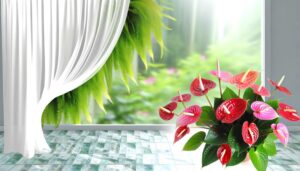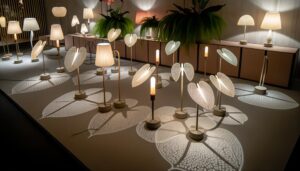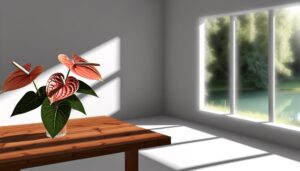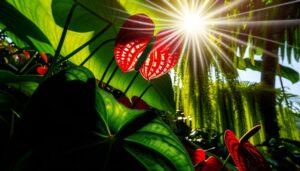Choosing Anthurium Plants for Your FB Profile Picture
Selecting the perfect Anthurium plant for your FB profile picture begins with choosing the right variety. Anthurium andraeanum showcases large, waxy spathes for bold statements, while A.
clarinervium's heart-shaped leaves offer elegance. Make sure your selected plant adds visual impact with vibrant colors—ranging from deep crimson to pure white—and glossy textures.
Match the leaf shape and hue to your personal style; sleek leaves suit minimalists, whereas wavy or heart-shaped leaves suit eclectic tastes. High humidity and proper care enhance their vibrancy, while thoughtful photography showcases their best features.
For detailed tips on plant care and capturing the perfect shot, keep exploring.

Key Takeaways
- Select vibrant anthurium colors like deep crimson or pure white for high visual impact.
- Choose large anthuriums for bold statements, or smaller ones for delicate elegance.
- Use heart-shaped or glossy leaves to match your personal style and create a cohesive look.
- Ensure the plant is well-lit and use a neutral background for a clean, striking photo.
- Maintain high humidity and proper drainage to keep your anthurium healthy and vibrant for the picture.
Understanding Anthurium Varieties
Understanding the various types of Anthurium plants is crucial for selecting the right species for your environment and care preferences.
Anthuriums come in numerous varieties, each with unique characteristics. The Anthurium andraeanum, commonly known as the Flamingo Flower, features large, waxy spathes and is ideal for bright, indirect light.
If you prefer a plant with striking foliage, consider Anthurium clarinervium, recognized for its heart-shaped leaves and prominent white veins.
For smaller spaces, the Anthurium scherzerianum, or Pigtail Plant, offers compact growth with twisted spathes.
Evaluating your available light, space, and humidity levels will guide you in choosing the right variety. Different species also have specific watering and soil requirements, so understanding these factors ensures optimal growth and health.
Considering Color and Vibrancy
When choosing Anthurium plants, consider the brightness and appeal of their blooms to enhance your space.
Pay attention to the hue and contrast of the flowers, as these elements can greatly impact the plant's overall visual effect.
Opt for colors that complement your existing decor or create striking focal points.
Brightness and Appeal
In selecting anthurium plants, you'll find that their brightness and appeal stem from their vibrant colors and glossy, heart-shaped spathes, which can range from deep crimson to pure white. These striking features can make your profile picture pop, providing a visually appealing and dynamic aesthetic. The spathes' glossy texture reflects light, enhancing their natural vibrancy.
| Color | Appeal Factor |
|---|---|
| Deep Crimson | Bold, intense, eye-catching |
| Bright Pink | Cheerful, lively, vibrant |
| Pure White | Elegant, pure, sophisticated |
| Light Green | Fresh, calming, rejuvenating |
Choosing the right anthurium color can amplify your profile's brightness. The glossiness of the spathes further accentuates this effect, making your photo stand out in an eye-pleasing manner.
Hue and Contrast
Selecting anthurium plants with the right shade and contrast can make a significant difference in highlighting their vibrant colors and guaranteeing they complement your environment seamlessly. Pay attention to the following considerations:
- Color Harmony: Choose shades that enhance your profile picture's background. Reds and pinks create a striking contrast against neutral or green backgrounds.
- Lighting Conditions: Make sure your chosen plant's colors pop under your preferred lighting. Bright, indirect light often brings out the most vivid hues.
- Leaf and Flower Contrast: Choose anthuriums with contrasting leaf and flower colors. For example, dark green leaves combined with bright red or white flowers can create an attention-grabbing effect.
Understanding these elements guarantees your anthurium stands out, making your profile picture truly captivating.
Size Matters: Big Vs. Small
When choosing between big and small anthurium plants, you'll need to ponder their visual impact and spatial requirements. Larger plants make a bold statement and can serve as focal points, while smaller ones are ideal for limited space and easier to maintain.
Evaluate your environment and maintenance capacity to select the right size for your needs.
Visual Impact Comparison
Evaluating anthurium plants starts with understanding how size influences their visual impact and overall presence in your space. Larger anthuriums create a bold statement, dominating your profile picture with their lush, expansive leaves and vibrant spathes. Conversely, smaller anthuriums offer a delicate, refined aesthetic that adds subtle elegance without overwhelming the scene.
Consider the following factors when comparing visual impact:
- Focal Point: Large anthuriums naturally draw attention, making them ideal if you want the plant to be the primary focus.
- Background Integration: Smaller anthuriums blend seamlessly with other elements, enhancing the overall harmony of your profile picture.
- Detail Visibility: Larger plants showcase intricate details more clearly, amplifying their visual richness.
Space and Maintenance
Considering the spatial demands and upkeep of anthurium plants, your choice between large and small varieties hinges on the available room and your willingness to manage their distinct care requirements.
Large anthuriums, with their broad leaves and expansive root systems, need ample space and regular repotting to thrive. You'll also need to maintain higher humidity and maintain consistent watering schedules to prevent leaf damage.
On the other hand, smaller anthuriums fit comfortably in limited spaces like desktops or shelves. They require less frequent repotting and are generally easier to manage concerning water and light needs. However, smaller varieties still need close attention to humidity and occasional pruning to maintain their compact form, ensuring they remain visually appealing and healthy.
Leaf Shapes and Textures
Anthurium plants exhibit a mesmerizing diversity in leaf shapes and textures, ranging from glossy, heart-shaped foliage to deeply veined, matte finishes. Understanding these variations can help you select the perfect plant for aesthetic appeal.
- Glossy Leaves: These leaves reflect light, giving a vibrant, polished look ideal for high-visibility settings.
- Heart-Shaped Leaves: This classic shape offers a romantic, inviting feel, making your profile picture warm and approachable.
- Deeply Veined Leaves: These leaves display intricate patterns that add texture and depth, perfect for a more sophisticated and detailed visual effect.
Choosing the right leaf shape and texture not only enhances visual appeal but also conveys specific moods and styles, aiding in creating a charming profile picture.
Matching Your Personal Style
By aligning the leaf shapes and textures of Anthurium plants with your personal style, you can create a cohesive and visually appealing environment that reflects your unique aesthetic preferences.
If you lean towards a modern, minimalist look, opt for Anthuriums with sleek, glossy leaves like the Anthurium andraeanum.
For a more eclectic or bohemian vibe, choose varieties with wavy or heart-shaped leaves, such as Anthurium clarinervium.
Consider the color palette as well—vibrant red or pink leaves can add a pop of color, while darker green varieties offer a subtler accent.
Don't forget to match the plant's pot to your decor; a stylish container can enhance the overall visual impact, integrating seamlessly with your existing design elements.
Seasonal Considerations
Understanding the impact of seasonal changes on Anthurium care is crucial to maintaining their vibrant health and appearance year-round. During different seasons, you'll need to adjust various environmental factors to keep your Anthurium thriving.
- Light: In winter, place your Anthurium near a bright window to compensate for reduced daylight. In summer, ensure indirect light to prevent leaf scorch.
- Temperature: Anthuriums prefer temperatures between 70-85°F. In colder months, avoid drafts and sudden temperature drops.
- Humidity: These tropical plants thrive in high humidity. In winter, use a humidifier or mist the leaves regularly to counteract dry indoor air.
Caring for Your Anthurium
To guarantee your Anthurium thrives, pay meticulous attention to its watering needs, soil composition, and pest control.
Water the plant only when the top inch of soil feels dry, ensuring excess water drains freely to prevent root rot. Use a well-aerated, peat-based soil mix that retains moisture but also provides adequate drainage.
Maintain humidity levels around 60-80%, using a humidifier if necessary. Fertilize monthly with a balanced, water-soluble fertilizer during the growing season.
Regularly inspect the plant for pests like aphids, spider mites, and mealybugs. If detected, treat infestations promptly with insecticidal soap or neem oil.
Prune dead or yellowing leaves to encourage new growth and maintain a healthy appearance for your profile picture.
Capturing the Perfect Photo
Once your Anthurium plant is thriving, it's time to capture its beauty by setting up the perfect lighting, angle, and background for a stunning photograph.
Confirm your plant is in a well-lit area, preferably with natural light to accentuate its vibrant colors.
Position your camera at an angle that showcases the distinctive shape of the leaves and flowers without causing harsh shadows.
A simple, clutter-free background will keep the focus on your Anthurium.
- Tips for a perfect photo:
- Use a white or neutral-colored background to make the plant stand out.
- Avoid using flash as it can create unwanted glares.
- Experiment with different angles to find the most flattering shot.
Conclusion
Coincidentally, as you explore selecting the perfect Anthurium for your Facebook profile picture, you'll find that thinking about varieties, colors, sizes, and textures aligns seamlessly with your personal style and seasonal preferences.
By understanding care needs and capturing a vibrant photo, you're not just showcasing a plant, but a piece of your personality.
This technical journey guarantees your profile picture isn't just a click, but a curated expression of you, blending botanical beauty with personal flair.






